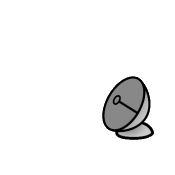The callsign is an identifier made of digits and letters, delivered by the authorities of each country to their licensed radioamateurs. The callsign is necessary to be allowed to emit on amateur frequencies. It is also broadly used within the radioamateur community to identify people.
QTH locator
The QTH locator (also known as the Maidenhead Locator System) is a compact way to describe a geographical position, with only a few characters which can be easily transmitted by radio (using Morse code, for example). It is broadly used by radioamateurs around the world. You can use this QTH locator to find your own QTH locator.
A QTH locator is made of 4 or 6 characters. The first and the second characters are letters, from A (considered as 0) to S (considered as 18), representing the longitude and the latitude, in steps of 20 degrees (longitude) and 10 degrees (latitude). The third and fourth characters are digits, which add some precision to the position by giving the number of steps of 2 degress (longitude) and 1 degrees (latitude) to add to the initial value. More precision can still be added by using the optional fifth and sixth characters, which are also letters, refining the grid to a precision of 5 arcminutes (longitude) and 2.5 arcminutes (latitude). To avoid negative numbers, the origin of the coordinate system is taken at 180°W, 90°S (that is -180.0° longitude, -90.0° latitude).
Example:
The location of Meudon, France, is: 48.80°N, 2.22°E
Using the QTH system origin: lat 138.80°, lon 182.22°
Converting the latitude in QTH steps: lat = 138.8° = 13 x 10° + 8 x 1° + 19 x 2.5' = _N_8_T (only even digits are used for latitude)
Converting the longitude in QTH steps: lat = 182.22° = 9 x 20° + 1 x 2° + 2 x 5' = J_1_C_ (only odd digits are used for longitude)
The QTH for Meudon is: JN18CT
